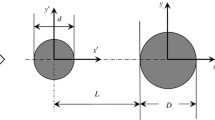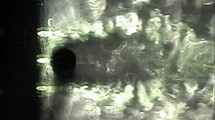Abstract
Shedding vortices in cross flow are of much practical importance in the analysis of flow induced vibrations of a steam generator. However, studies of shedding vortex are still few in present, especially in shedding patterns and its influences on lift performances. In this paper, five basic shedding patterns were investigated by numerical simulations of a 2D unsteady flow around a bundle with 253 cylinders. The numerical results clearly demonstrated that flow in line is the most common pattern. On the hand, the other four shedding patterns, cross in line, cross near line near, cross near line far and cross far line near, appear randomly. Influences of shedding vortices on lift performances were concluded as lift enhancement, lift pit and lift lag. These numerical results can provide a basic knowledge of shedding vortices for cylinders and can precisely quantify their influences on unsteady lift performances.
Similar content being viewed by others
References
J. Baek, A panel cointegration analysis of CO2 emissions, nuclear energy and income in major nuclear generating countries, Applied Energy, 145 (2015) 133–138.
M. Al-Zareer, I. Dincer and M. A. Rosen, Performance analysis of a supercritical water-cooled nuclear reactor integrated with a combined cycle, a Cu-Cl thermochemical cycle and a hydrogen compression system, Applied Energy, 195 (2017) 646–658.
R. Pattupara and R. Kannan, Alternative low-carbon electricity pathways in Switzerland and it’s neighbouring countries under a nuclear phase-out scenario, Applied Energy, 172 (2016).
R. Govardhan and C. H. K. Williamson, Modes of vortex formation and frequency response of a freely vibrating cylinder, Journal of Fluid Mechanics, 420 (2000) 85–130.
N. Maïzi and E. Assoumou, Future prospects for nuclear power in France, Applied Energy, 136 (2014) 849–859.
L. Tang, L. Yu and K. He, A novel data-characteristic-driven modeling methodology for nuclear energy consumption forecasting, Applied Energy, 128 (2014) 1–14.
S. Kosai and H. Unesaki, Quantitative analysis on the impact of nuclear energy supply disruption on electricity supply security, Applied Energy, 208 (2017) 1198–1207.
L.-C. Hsu, C.-L. Chen and J.-Z. Ye, A study of flow patterns for staggered cylinders at low Reynolds number by spectral element method, Journal of Mechanical Science and Technology, 31 (2017) 2765–2780.
D. Tang, S. Bao, L. Luo, H. Zhu and H. Cui, A CFD/CSD coupled method with high order and its applications in flow induced vibrations of tube arrays in cross flow, Annals of Nuclear Energy, 130 (2019) 347–356.
M. Coutanceau and J. R. Defaye, Circular cylinder wake configurations: A flow visualization survey, Applied Mechanics Reviews, 44(5) (1991) 255–305.
P. W. Bearman and M. M. Zdravkovich, Flow around a circular cylinder near a plane boundary, Journal of Fluid Mechanics, 89(1) (1978) 639–650.
G. Buresti and A. Lanciotti, Mean and fluctuating forces on a circular cylinder in cross-flow near a plane surface, Journal of Wind Engineering And Industrial Aerodynamics, 41 (1992) 1–3.
T. Nishino, G. T. Roberts and X. Zhang, Vortex shedding from a circular cylinder near a moving ground, Physics of Fluids, 19(2) (2007) 025103.
Q. Wang, M. Li and S. Xu, Experimental study on vortex induced vibration (VIV) of a wide-D-section cylinder in a cross flow, Theoretical and Applied Mechanics Letters, 5(1) (2015) 39–44.
Bundesamt für Energie, Schweizerische Elektrizitätsstatistik, Swiss Federal Statistical Office, Bern (2014).
D. Sumner, M. D. Richards and O. O. Akosile, Two staggered circular cylinders of equal diameter in cross-flow, Journal of Fluids and Structures, 20(2) (2005) 255–276.
S. J. Price, M. P. Paidoussis and S. Krishnamoorthy, Cross-flow past a pair of nearly in-line cylinders with the upstream cylinder subjected to a transverse harmonic oscillation, Journal of Fluids and Structures, 23(1) (2007) 39–57.
M. M. Zdravkovich, The effects of interference between circular cylinders in cross flow, Journal of Fluids and Structures, 1(2) (1987) 239–261.
G. R. S. Assi, N. Srinil, C. M. Freire and I. Korkischko, Experimental investigation of flow-induced vibration interference between two cylinders, Journal of Fluids and Structures, 22(6) (2006) 819–827.
X. Li, X. Wu and S. He, Numerical investigation of the turbulent cross flow and heat transfer in a wall bounded tube bundle, International Journal of Numerical Methods for Heat & Fluid Flow, 75(1) (2014) 127–139.
M. M. Zdravkovich, Flow Around Circular Cylinders, Oxford University Press, New York (2003).
D. S. Weavera and M. Elkashlana, On the number of tube rows required to study cross-flow induced vibrations in tube banks, Journal of Sound and Vibration, 75(2) (1981) 265–273.
R. Duan and S. Jiang, Numerical investigation of gas flow distribution and thermal mixing in helically coiled tube bundle, Journal of Nuclear Science And Technology, 45(7) (2008) 704–711.
B. de Pedro, J. Parrondo, C. Meskell and J. F. Oro, CFD modelling of the cross-flow through normal triangular tube arrays with one tube undergoing forced vibrations or flu-idelastic instability, Journal of Fluids and Structures, 64 (2016) 67–86.
A. G. Abramov, A. M. Levchenya, E. M. Smirnov and P. E. Smirnov, Numerical simulation of liquid metal turbulent heat transfer from an inline tube bundle in cross-flow, St. Petersburg Polytechnical University Journal: Physics and Mathematics, 4 (2015) 356–363.
A. Zanotti, R. Nilifard, G. Gibertini, A. Guardone and G. Quaranta, Assessment of 2D/3D numerical modeling for deep dynamic stall experiments, Journal of Fluids and Structures, 51 (2014) 97–115.
S. Wang, D. B. Ingham, L. Ma, M. Pourkashanian and Z. Tao, Turbulence modeling of deep dynamic stall at relatively low Reynolds number, Journal of Fluids and Structures, 33 (2012) 191–209.
A. Roshko, On the wake and drag of bluff bodies on the wake and drag of bluff bodies, Jour Aeronautical Sci., 22(2) (1955) 124–132.
A. Roshko, Experiments on the flow past a circular cylinder at very high reynolds number, Journal of Fluid Mechanics, 10(3) (1960) 345–356.
J. H. Gerrard, The mechanics of the formation region of vortices behind bluff bodies, Journal of Fluid Mechanics, 25(2) (1966) 401–413.
A. S. Grove, F. H. Shair, E. E. Petersen and A. Acrivos, An experimental investigation of the steady separated flow past a circular cylinder, Journal of Fluid Mechanics, 19 (1964) 60–80.
S. S. Paul, S. J. Ormiston and M. F. Tachie, Experimental and numerical investigation of turbulent cross-flow in a staggered tube bundle, International Journal of Heat & Fluid Flow, 29(2) (2008) 387–414.
J. K. Ostanek and K. A. Thole, Wake development in staggered short cylinder arrays within a channel, Experiments in Fluids, 53(3) (2012) 673–697.
C. K. Mangrulkar, A. S. Dhoble, S. G. Chakrabarty and U. S. Wankhede, Experimental and CFD prediction of heat transfer and friction factor characteristics in cross flow tube bank with integral splitter plate, International Journal of Heat & Mass Transfer, 104 (2017) 964–978.
D. Tang, S. Bao, L. Luo, J. Mao, B. Lv and H. Guo, Study on the aeroelastic responses of a wind turbine using a coupled multibody-FVW method, Energy, 141 (2017) 2300–2313.
TEMA, Standards of the Tubular Exchanger Manufacturers Association, Eighth edition (1999).
GB151-99, Tubular Heat Exchangers, Standards Press of China (1999).
M. Xu and M. Wei, Using adjoint approach to study flapping wings, Journal of Fluid Mechanics, 799 (2016) 56–99.
M. Xu, M. Wei, T. Yang and Y. S. Lee, An embedded boundary approach for the simulation of a flexible flapping wing at different density ratio, European Journal of Mechanics (B/Fluids), 55 (2016) 146–156.
D. Tang, Z. Fan, M. Lei, B. Lv, L. Yu and H. Cui, A combined airfoil with secondary feather inspired by the golden eagle and its influences on the aerodynamics, Chinese Physics B, 28 (3) (2019) 034702.
C. Moulinec, M. J. B. M. Pourquie, B. J. Boersma, T. Buchal and F. T. M. Nieuwstadt, Direct numerical simulation on a Cartesian mesh of the flow through a tube bundle, International Journal of Computational Fluid Dynamics, 18(1) (2004) 1–14.
H. Jiang, L. Cheng, S. Draper and H. An, Prediction of the secondary wake instability of a circular cylinder with direct numerical simulation, Computers & Fluids, 149 (2017) 172–180.
F. Shang, L. Hu, X. Sun, Q. Wang and A. Palacios, Flame downwash length evolution of non-premixed gaseous fuel jets in cross-flow: Experiments and a new correlation, Applied Energy, 198 (2017) 99–107.
V. Shinde, T. Marcel, Y. Hoarau, T. Deloze and G. Harran, Numerical simulation of the fluid-structure interaction in a tube array under cross flow at moderate and high Reynolds number, Journal of Fluids and Structures, 47 (2014) 99–113.
Y. Wang, A. Shukla and S. Liu, A state of art review on methodologies for heat transfer and energy flow characteristics of the active building envelopes, Renewable & Sustainable Energy Reviews, 78 (2017) 1102–1116.
F. R. Menter, Two-equation eddy-viscosity turbulence models for engineering application, AIAA. Journal, 32(8) (1994) 1598–1605.
I.-C. Chu, H. J. Chung and S. Lee, Flow-induced vibration of nuclear steam generator U-tubes in two-phase flow, Nuclear Engineering and Design, 241(5) (2011) 1508–1515.
J. Duan, J. Gong, H. Yao, T. Deng and J. Zhou, Numerical modeling for stratified gas-liquid flow and heat transfer in pipeline, Applied Energy, 115 (2014) 83–94.
E. Achenbach, Distribution of local pressure and skin friction around a circular cylinder in cross-flow up to Re=5×106, Journal of Fluid Mechanics, 34(4) (1968) 625–639.
D. Tang, S. Bao, M. Xu, L. Luo, B. Lv, L. Yu and H. Cui, On the number of tubes required to study oscillating vortices and frequency spectrums of tube arrays in cross flow, Annals of Nuclear Energy, 124 (2019) 198–210.
A. Surendran, M. A. Heckl, L. Peerlings, S. Boij, H. Boden and A. Hirschberg, Aeroacoustic response of an array of tubes with and without bias-flow, Journal of Sound and Vibration, 434 (2018) 1–16.
Q. M. Al-Mdallal and F. M. Mahfouz, Heat transfer from a heated non-rotating cylinder performing circular motion in a uniform stream, International Journal of Heat & Mass Transfer, 112 (2017) 147–157.
Acknowledgments
The authors would like to thank the referees for their good and valuable suggestions which improved this paper greatly. The work is supported by National Natural Science Foundation of China (51705459) and China Postdoctoral Science Foundation.
Author information
Authors and Affiliations
Corresponding author
Additional information
Recommended by Associate Editor Hyoung-gwon Choi
Di Tang received his Ph.D. degree in Nanjing University of Aeronautics and Astronautics, China. Currently, he is a researcher at Zhejiang University of Technology, China. His research interests include the fluid induced vibrations, vortex flow and bioinspired materials.
Rights and permissions
About this article
Cite this article
Tang, D., Bao, S., Lv, B. et al. Investigation of shedding patterns and its influences on lift performances of a cylinder bundle in cross flow. J Mech Sci Technol 33, 2651–2663 (2019). https://doi.org/10.1007/s12206-019-0513-9
Received:
Revised:
Accepted:
Published:
Issue Date:
DOI: https://doi.org/10.1007/s12206-019-0513-9




